2014 NISSAN QUEST seat adjustment
[x] Cancel search: seat adjustmentPage 148 of 482
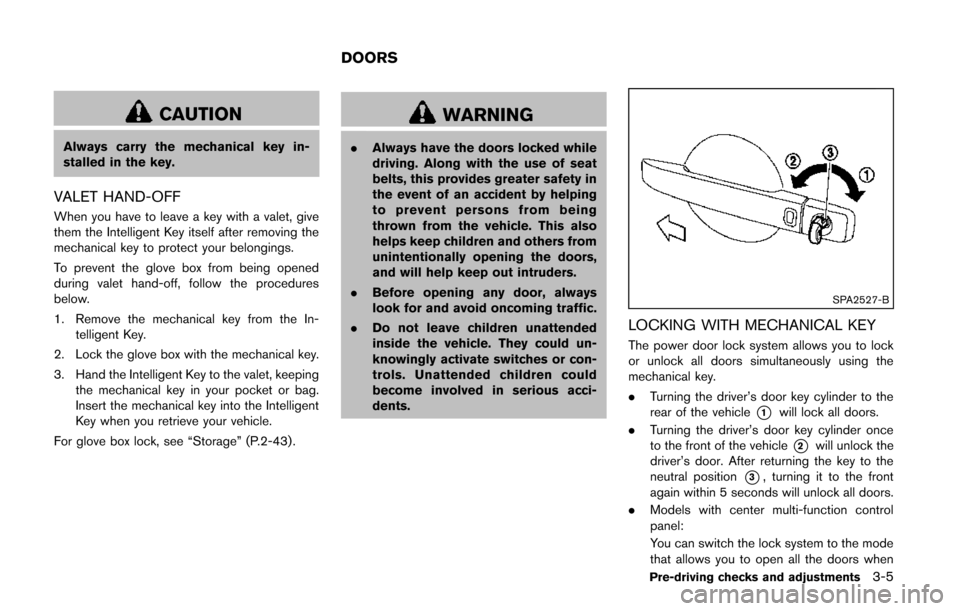
CAUTION
Always carry the mechanical key in-
stalled in the key.
VALET HAND-OFF
When you have to leave a key with a valet, give
them the Intelligent Key itself after removing the
mechanical key to protect your belongings.
To prevent the glove box from being opened
during valet hand-off, follow the procedures
below.
1. Remove the mechanical key from the In-telligent Key.
2. Lock the glove box with the mechanical key.
3. Hand the Intelligent Key to the valet, keeping the mechanical key in your pocket or bag.
Insert the mechanical key into the Intelligent
Key when you retrieve your vehicle.
For glove box lock, see “Storage” (P.2-43) .
WARNING
. Always have the doors locked while
driving. Along with the use of seat
belts, this provides greater safety in
the event of an accident by helping
to prevent persons from being
thrown from the vehicle. This also
helps keep children and others from
unintentionally opening the doors,
and will help keep out intruders.
. Before opening any door, always
look for and avoid oncoming traffic.
. Do not leave children unattended
inside the vehicle. They could un-
knowingly activate switches or con-
trols. Unattended children could
become involved in serious acci-
dents.
SPA2527-B
LOCKING WITH MECHANICAL KEY
The power door lock system allows you to lock
or unlock all doors simultaneously using the
mechanical key.
.Turning the driver’s door key cylinder to the
rear of the vehicle
*1will lock all doors.
. Turning the driver’s door key cylinder once
to the front of the vehicle
*2will unlock the
driver’s door. After returning the key to the
neutral position
*3, turning it to the front
again within 5 seconds will unlock all doors.
. Models with center multi-function control
panel:
You can switch the lock system to the mode
that allows you to open all the doors when
Pre-driving checks and adjustments3-5
DOORS
Page 175 of 482
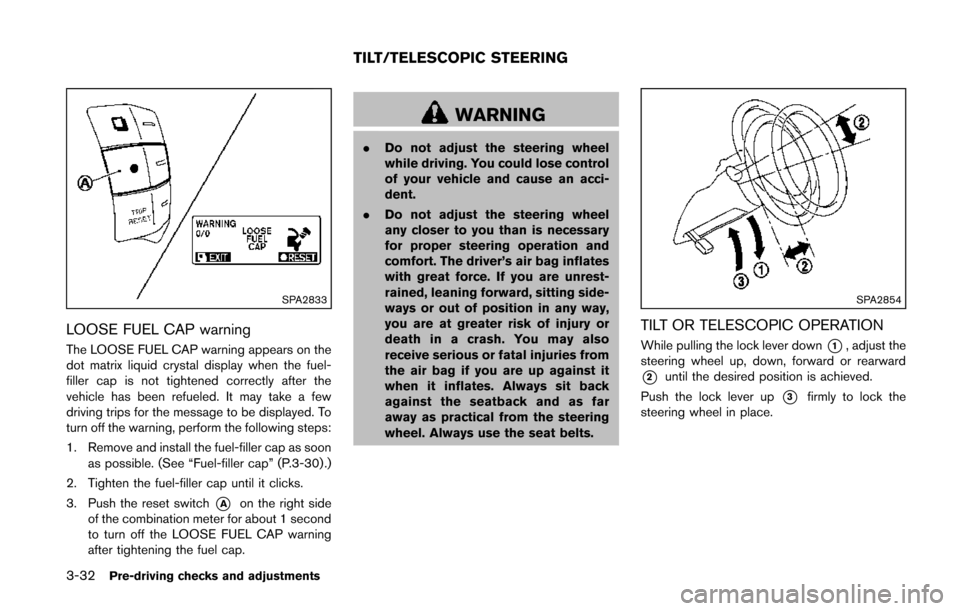
3-32Pre-driving checks and adjustments
SPA2833
LOOSE FUEL CAP warning
The LOOSE FUEL CAP warning appears on the
dot matrix liquid crystal display when the fuel-
filler cap is not tightened correctly after the
vehicle has been refueled. It may take a few
driving trips for the message to be displayed. To
turn off the warning, perform the following steps:
1. Remove and install the fuel-filler cap as soonas possible. (See “Fuel-filler cap” (P.3-30) .)
2. Tighten the fuel-filler cap until it clicks.
3. Push the reset switch
*Aon the right side
of the combination meter for about 1 second
to turn off the LOOSE FUEL CAP warning
after tightening the fuel cap.
WARNING
. Do not adjust the steering wheel
while driving. You could lose control
of your vehicle and cause an acci-
dent.
. Do not adjust the steering wheel
any closer to you than is necessary
for proper steering operation and
comfort. The driver’s air bag inflates
with great force. If you are unrest-
rained, leaning forward, sitting side-
ways or out of position in any way,
you are at greater risk of injury or
death in a crash. You may also
receive serious or fatal injuries from
the air bag if you are up against it
when it inflates. Always sit back
against the seatback and as far
away as practical from the steering
wheel. Always use the seat belts.
SPA2854
TILT OR TELESCOPIC OPERATION
While pulling the lock lever down*1, adjust the
steering wheel up, down, forward or rearward
*2until the desired position is achieved.
Push the lock lever up
*3firmly to lock the
steering wheel in place.
TILT/TELESCOPIC STEERING
Page 179 of 482
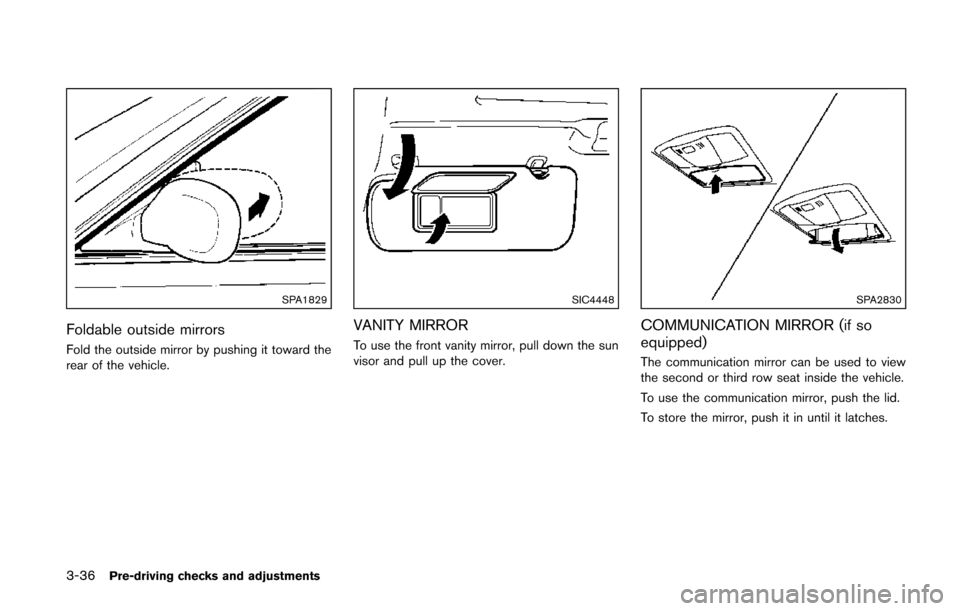
3-36Pre-driving checks and adjustments
SPA1829
Foldable outside mirrors
Fold the outside mirror by pushing it toward the
rear of the vehicle.
SIC4448
VANITY MIRROR
To use the front vanity mirror, pull down the sun
visor and pull up the cover.
SPA2830
COMMUNICATION MIRROR (if so
equipped)
The communication mirror can be used to view
the second or third row seat inside the vehicle.
To use the communication mirror, push the lid.
To store the mirror, push it in until it latches.
Page 180 of 482
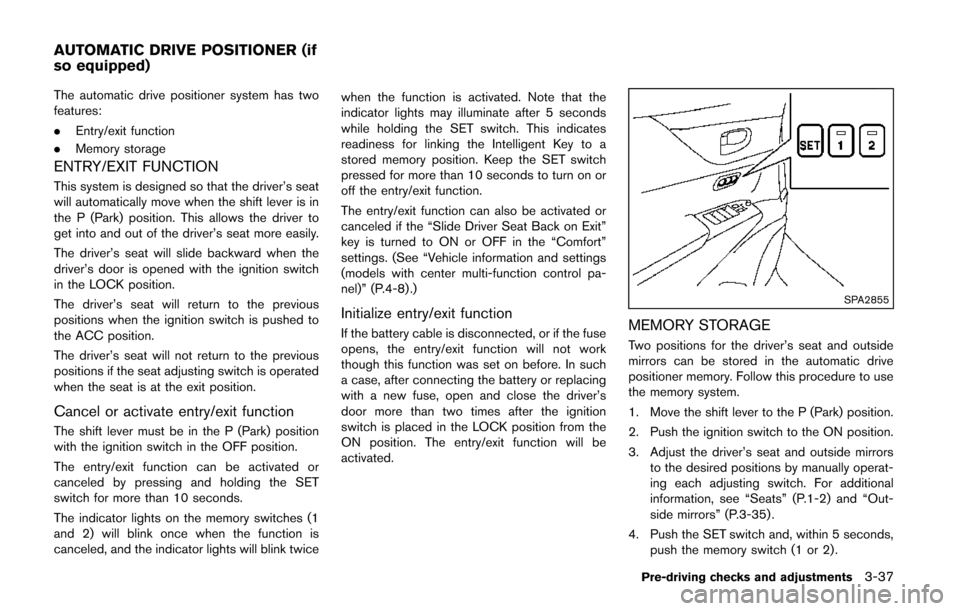
The automatic drive positioner system has two
features:
.Entry/exit function
. Memory storage
ENTRY/EXIT FUNCTION
This system is designed so that the driver’s seat
will automatically move when the shift lever is in
the P (Park) position. This allows the driver to
get into and out of the driver’s seat more easily.
The driver’s seat will slide backward when the
driver’s door is opened with the ignition switch
in the LOCK position.
The driver’s seat will return to the previous
positions when the ignition switch is pushed to
the ACC position.
The driver’s seat will not return to the previous
positions if the seat adjusting switch is operated
when the seat is at the exit position.
Cancel or activate entry/exit function
The shift lever must be in the P (Park) position
with the ignition switch in the OFF position.
The entry/exit function can be activated or
canceled by pressing and holding the SET
switch for more than 10 seconds.
The indicator lights on the memory switches (1
and 2) will blink once when the function is
canceled, and the indicator lights will blink twice when the function is activated. Note that the
indicator lights may illuminate after 5 seconds
while holding the SET switch. This indicates
readiness for linking the Intelligent Key to a
stored memory position. Keep the SET switch
pressed for more than 10 seconds to turn on or
off the entry/exit function.
The entry/exit function can also be activated or
canceled if the “Slide Driver Seat Back on Exit”
key is turned to ON or OFF in the “Comfort”
settings. (See “Vehicle information and settings
(models with center multi-function control pa-
nel)” (P.4-8) .)
Initialize entry/exit function
If the battery cable is disconnected, or if the fuse
opens, the entry/exit function will not work
though this function was set on before. In such
a case, after connecting the battery or replacing
with a new fuse, open and close the driver’s
door more than two times after the ignition
switch is placed in the LOCK position from the
ON position. The entry/exit function will be
activated.
SPA2855
MEMORY STORAGE
Two positions for the driver’s seat and outside
mirrors can be stored in the automatic drive
positioner memory. Follow this procedure to use
the memory system.
1. Move the shift lever to the P (Park) position.
2. Push the ignition switch to the ON position.
3. Adjust the driver’s seat and outside mirrors
to the desired positions by manually operat-
ing each adjusting switch. For additional
information, see “Seats” (P.1-2) and “Out-
side mirrors” (P.3-35) .
4. Push the SET switch and, within 5 seconds, push the memory switch (1 or 2) .
Pre-driving checks and adjustments3-37
AUTOMATIC DRIVE POSITIONER (if
so equipped)
Page 181 of 482
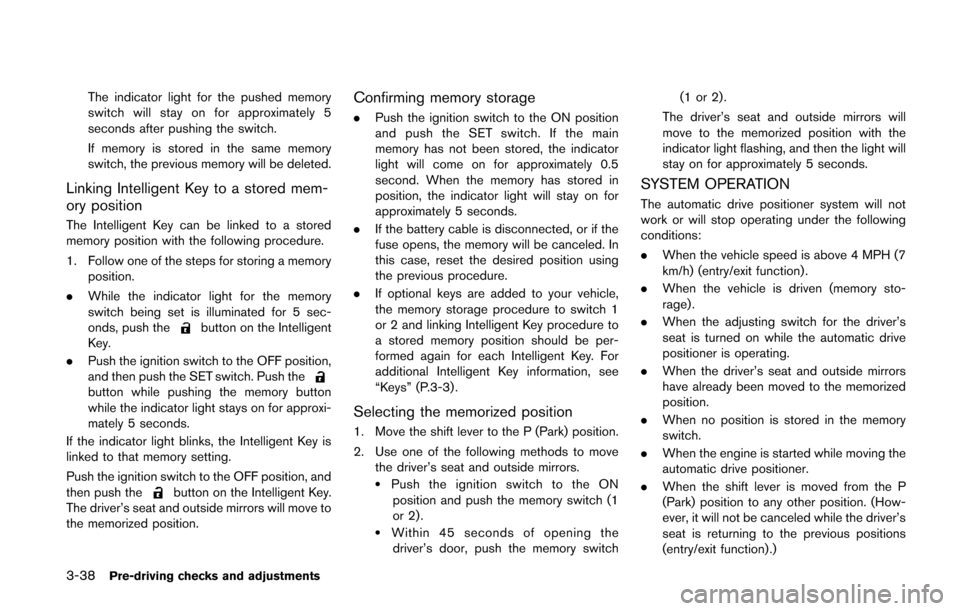
3-38Pre-driving checks and adjustments
The indicator light for the pushed memory
switch will stay on for approximately 5
seconds after pushing the switch.
If memory is stored in the same memory
switch, the previous memory will be deleted.
Linking Intelligent Key to a stored mem-
ory position
The Intelligent Key can be linked to a stored
memory position with the following procedure.
1. Follow one of the steps for storing a memoryposition.
. While the indicator light for the memory
switch being set is illuminated for 5 sec-
onds, push the
button on the Intelligent
Key.
. Push the ignition switch to the OFF position,
and then push the SET switch. Push the
button while pushing the memory button
while the indicator light stays on for approxi-
mately 5 seconds.
If the indicator light blinks, the Intelligent Key is
linked to that memory setting.
Push the ignition switch to the OFF position, and
then push the
button on the Intelligent Key.
The driver’s seat and outside mirrors will move to
the memorized position.
Confirming memory storage
. Push the ignition switch to the ON position
and push the SET switch. If the main
memory has not been stored, the indicator
light will come on for approximately 0.5
second. When the memory has stored in
position, the indicator light will stay on for
approximately 5 seconds.
. If the battery cable is disconnected, or if the
fuse opens, the memory will be canceled. In
this case, reset the desired position using
the previous procedure.
. If optional keys are added to your vehicle,
the memory storage procedure to switch 1
or 2 and linking Intelligent Key procedure to
a stored memory position should be per-
formed again for each Intelligent Key. For
additional Intelligent Key information, see
“Keys” (P.3-3) .
Selecting the memorized position
1. Move the shift lever to the P (Park) position.
2. Use one of the following methods to move
the driver’s seat and outside mirrors.
.Push the ignition switch to the ONposition and push the memory switch (1
or 2) .
.Within 45 seconds of opening thedriver’s door, push the memory switch (1 or 2) .
The driver’s seat and outside mirrors will
move to the memorized position with the
indicator light flashing, and then the light will
stay on for approximately 5 seconds.
SYSTEM OPERATION
The automatic drive positioner system will not
work or will stop operating under the following
conditions:
. When the vehicle speed is above 4 MPH (7
km/h) (entry/exit function) .
. When the vehicle is driven (memory sto-
rage).
. When the adjusting switch for the driver’s
seat is turned on while the automatic drive
positioner is operating.
. When the driver’s seat and outside mirrors
have already been moved to the memorized
position.
. When no position is stored in the memory
switch.
. When the engine is started while moving the
automatic drive positioner.
. When the shift lever is moved from the P
(Park) position to any other position. (How-
ever, it will not be canceled while the driver’s
seat is returning to the previous positions
(entry/exit function).)
Page 408 of 482
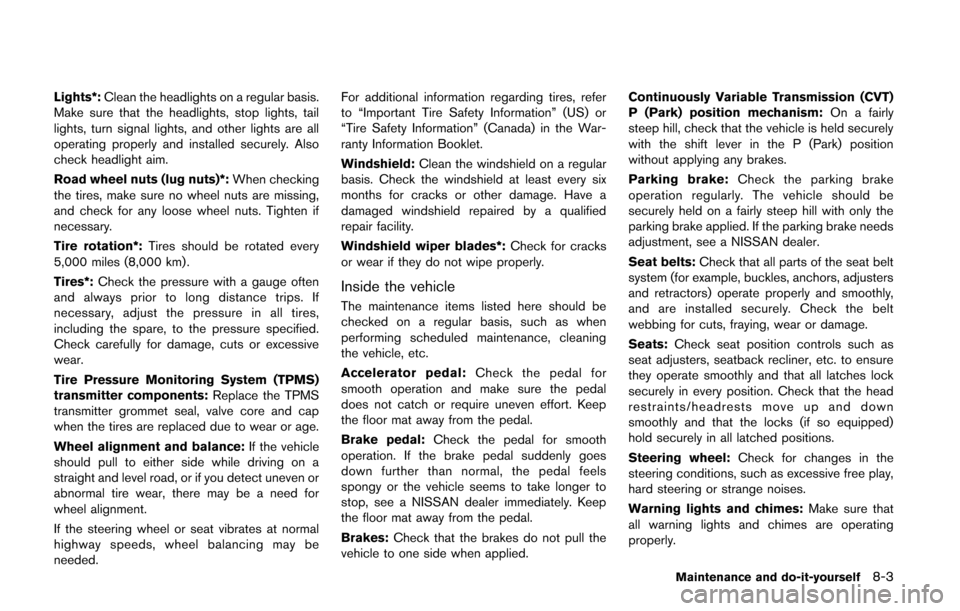
Lights*:Clean the headlights on a regular basis.
Make sure that the headlights, stop lights, tail
lights, turn signal lights, and other lights are all
operating properly and installed securely. Also
check headlight aim.
Road wheel nuts (lug nuts)*: When checking
the tires, make sure no wheel nuts are missing,
and check for any loose wheel nuts. Tighten if
necessary.
Tire rotation*: Tires should be rotated every
5,000 miles (8,000 km) .
Tires*: Check the pressure with a gauge often
and always prior to long distance trips. If
necessary, adjust the pressure in all tires,
including the spare, to the pressure specified.
Check carefully for damage, cuts or excessive
wear.
Tire Pressure Monitoring System (TPMS)
transmitter components: Replace the TPMS
transmitter grommet seal, valve core and cap
when the tires are replaced due to wear or age.
Wheel alignment and balance: If the vehicle
should pull to either side while driving on a
straight and level road, or if you detect uneven or
abnormal tire wear, there may be a need for
wheel alignment.
If the steering wheel or seat vibrates at normal
highway speeds, wheel balancing may be
needed. For additional information regarding tires, refer
to “Important Tire Safety Information” (US) or
“Tire Safety Information” (Canada) in the War-
ranty Information Booklet.
Windshield:
Clean the windshield on a regular
basis. Check the windshield at least every six
months for cracks or other damage. Have a
damaged windshield repaired by a qualified
repair facility.
Windshield wiper blades*: Check for cracks
or wear if they do not wipe properly.
Inside the vehicle
The maintenance items listed here should be
checked on a regular basis, such as when
performing scheduled maintenance, cleaning
the vehicle, etc.
Accelerator pedal: Check the pedal for
smooth operation and make sure the pedal
does not catch or require uneven effort. Keep
the floor mat away from the pedal.
Brake pedal: Check the pedal for smooth
operation. If the brake pedal suddenly goes
down further than normal, the pedal feels
spongy or the vehicle seems to take longer to
stop, see a NISSAN dealer immediately. Keep
the floor mat away from the pedal.
Brakes: Check that the brakes do not pull the
vehicle to one side when applied. Continuously Variable Transmission (CVT)
P (Park) position mechanism:
On a fairly
steep hill, check that the vehicle is held securely
with the shift lever in the P (Park) position
without applying any brakes.
Parking brake: Check the parking brake
operation regularly. The vehicle should be
securely held on a fairly steep hill with only the
parking brake applied. If the parking brake needs
adjustment, see a NISSAN dealer.
Seat belts: Check that all parts of the seat belt
system (for example, buckles, anchors, adjusters
and retractors) operate properly and smoothly,
and are installed securely. Check the belt
webbing for cuts, fraying, wear or damage.
Seats: Check seat position controls such as
seat adjusters, seatback recliner, etc. to ensure
they operate smoothly and that all latches lock
securely in every position. Check that the head
restraints/headrests move up and down
smoothly and that the locks (if so equipped)
hold securely in all latched positions.
Steering wheel: Check for changes in the
steering conditions, such as excessive free play,
hard steering or strange noises.
Warning lights and chimes: Make sure that
all warning lights and chimes are operating
properly.
Maintenance and do-it-yourself8-3
Page 475 of 482
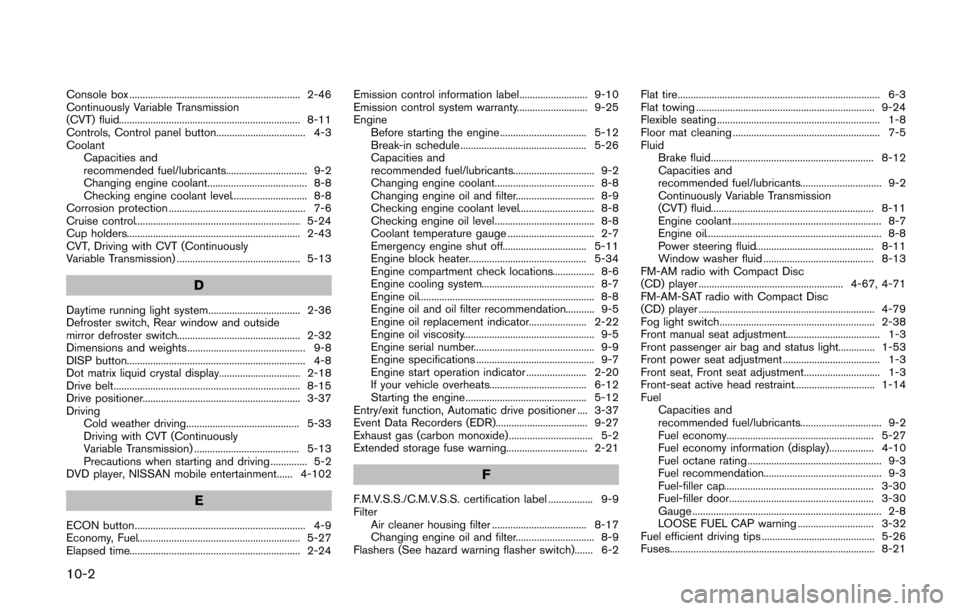
10-2
Console box ................................................................. 2-46
Continuously Variable Transmission
(CVT) fluid..................................................................... 8-11
Controls, Control panel button.................................. 4-3
Coolant Capacities and
recommended fuel/lubricants............................... 9-2
Changing engine coolant...................................... 8-8
Checking engine coolant level............................. 8-8
Corrosion protection .................................................... 7-6
Cruise control............................................................... 5-24
Cup holders.................................................................. 2-43
CVT, Driving with CVT (Continuously
Variable Transmission) ............................................... 5-13
D
Daytime running light system................................... 2-36
Defroster switch, Rear window and outside
mirror defroster switch............................................... 2-32
Dimensions and weights............................................. 9-8
DISP button.................................................................... 4-8
Dot matrix liquid crystal display............................... 2-18
Drive belt....................................................................... 8-15
Drive positioner............................................................ 3-37
Driving Cold weather driving........................................... 5-33
Driving with CVT (Continuously
Variable Transmission) ........................................ 5-13
Precautions when starting and driving .............. 5-2
DVD player, NISSAN mobile entertainment...... 4-102
E
ECON button................................................................. 4-9
Economy, Fuel.............................................................. 5-27
Elapsed time................................................................. 2-24 Emission control information label.......................... 9-10
Emission control system warranty........................... 9-25
Engine Before starting the engine................................. 5-12
Break-in schedule ................................................ 5-26
Capacities and
recommended fuel/lubricants............................... 9-2
Changing engine coolant...................................... 8-8
Changing engine oil and filter.............................. 8-9
Checking engine coolant level............................. 8-8
Checking engine oil level...................................... 8-8
Coolant temperature gauge ................................. 2-7
Emergency engine shut off................................ 5-11
Engine block heater............................................. 5-34
Engine compartment check locations................ 8-6
Engine cooling system........................................... 8-7
Engine oil................................................................... 8-8
Engine oil and oil filter recommendation........... 9-5
Engine oil replacement indicator...................... 2-22
Engine oil viscosity.................................................. 9-5
Engine serial number.............................................. 9-9
Engine specifications ............................................. 9-7
Engine start operation indicator ....................... 2-20
If your vehicle overheats..................................... 6-12
Starting the engine .............................................. 5-12
Entry/exit function, Automatic drive positioner .... 3-37
Event Data Recorders (EDR)................................... 9-27
Exhaust gas (carbon monoxide)................................ 5-2
Extended storage fuse warning............................... 2-21
F
F.M.V.S.S./C.M.V.S.S. certification label ................. 9-9
Filter Air cleaner housing filter .................................... 8-17
Changing engine oil and filter.............................. 8-9
Flashers (See hazard warning flasher switch)....... 6-2 Flat tire............................................................................. 6-3
Flat towing .................................................................... 9-24
Flexible seating .............................................................. 1-8
Floor mat cleaning ........................................................ 7-5
Fluid Brake fluid.............................................................. 8-12
Capacities and
recommended fuel/lubricants............................... 9-2
Continuously Variable Transmission
(CVT) fluid.............................................................. 8-11
Engine coolant......................................................... 8-7
Engine oil................................................................... 8-8
Power steering fluid............................................. 8-11
Window washer fluid .......................................... 8-13
FM-AM radio with Compact Disc
(CD) player ....................................................... 4-67, 4-71
FM-AM-SAT radio with Compact Disc
(CD) player ................................................................... 4-79
Fog light switch........................................................... 2-38
Front manual seat adjustment.................................... 1-3
Front passenger air bag and status light.............. 1-53
Front power seat adjustment ..................................... 1-3
Front seat, Front seat adjustment............................. 1-3
Front-seat active head restraint............................... 1-14
Fuel Capacities and
recommended fuel/lubricants............................... 9-2
Fuel economy........................................................ 5-27
Fuel economy information (display)................. 4-10
Fuel octane rating ................................................... 9-3
Fuel recommendation............................................. 9-3
Fuel-filler cap......................................................... 3-30
Fuel-filler door....................................................... 3-30
Gauge ........................................................................ 2-8
LOOSE FUEL CAP warning ............................. 3-32
Fuel efficient driving tips ........................................... 5-26
Fuses.............................................................................. 8-21
Page 477 of 482
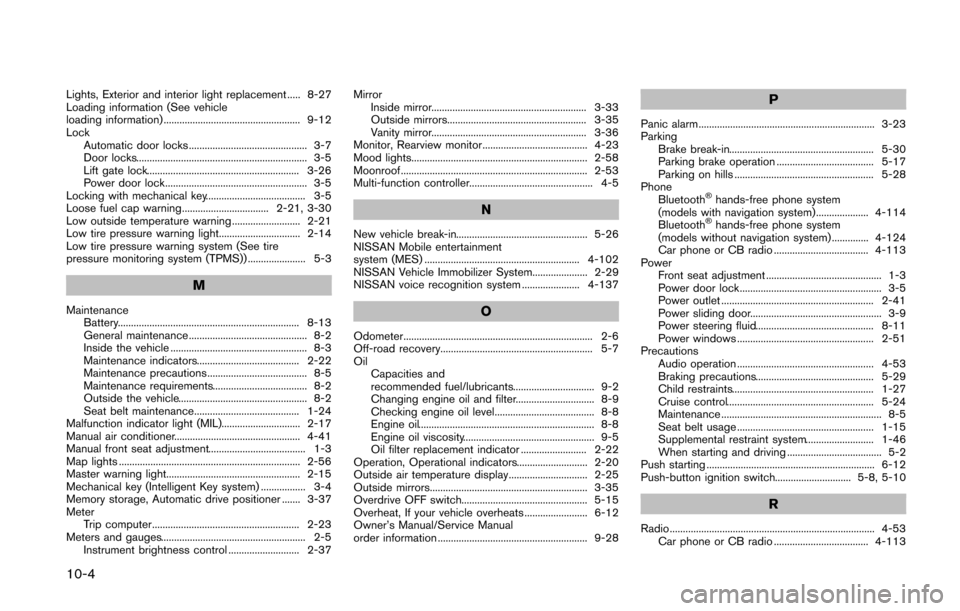
10-4
Lights, Exterior and interior light replacement ..... 8-27
Loading information (See vehicle
loading information) .................................................... 9-12
LockAutomatic door locks ............................................. 3-7
Door locks................................................................. 3-5
Lift gate lock.......................................................... 3-26
Power door lock...................................................... 3-5
Locking with mechanical key...................................... 3-5
Loose fuel cap warning................................. 2-21, 3-30
Low outside temperature warning .......................... 2-21
Low tire pressure warning light............................... 2-14
Low tire pressure warning system (See tire
pressure monitoring system (TPMS)) ...................... 5-3
M
Maintenance Battery..................................................................... 8-13
General maintenance ............................................. 8-2
Inside the vehicle .................................................... 8-3
Maintenance indicators....................................... 2-22
Maintenance precautions...................................... 8-5
Maintenance requirements.................................... 8-2
Outside the vehicle................................................. 8-2
Seat belt maintenance........................................ 1-24
Malfunction indicator light (MIL).............................. 2-17
Manual air conditioner................................................ 4-41
Manual front seat adjustment..................................... 1-3
Map lights ..................................................................... 2-56
Master warning light................................................... 2-15
Mechanical key (Intelligent Key system) ................. 3-4
Memory storage, Automatic drive positioner ....... 3-37
Meter Trip computer........................................................ 2-23
Meters and gauges....................................................... 2-5 Instrument brightness control ........................... 2-37 Mirror
Inside mirror........................................................... 3-33
Outside mirrors..................................................... 3-35
Vanity mirror........................................................... 3-36
Monitor, Rearview monitor........................................ 4-23
Mood lights................................................................... 2-58
Moonroof....................................................................... 2-53
Multi-function controller............................................... 4-5
N
New vehicle break-in.................................................. 5-26
NISSAN Mobile entertainment
system (MES) ........................................................... 4-102
NISSAN Vehicle Immobilizer System..................... 2-29
NISSAN voice recognition system ...................... 4-137
O
Odometer........................................................................ 2-6
Off-road recovery.......................................................... 5-7
Oil Capacities and
recommended fuel/lubricants............................... 9-2
Changing engine oil and filter.............................. 8-9
Checking engine oil level...................................... 8-8
Engine oil................................................................... 8-8
Engine oil viscosity.................................................. 9-5
Oil filter replacement indicator ......................... 2-22
Operation, Operational indicators........................... 2-20
Outside air temperature display.............................. 2-25
Outside mirrors............................................................ 3-35
Overdrive OFF switch................................................ 5-15
Overheat, If your vehicle overheats ........................ 6-12
Owner’s Manual/Service Manual
order information ......................................................... 9-28
P
Panic alarm................................................................... 3-23
Parking Brake break-in....................................................... 5-30
Parking brake operation ..................................... 5-17
Parking on hills ..................................................... 5-28
Phone Bluetooth
®hands-free phone system
(models with navigation system).................... 4-114
Bluetooth
®hands-free phone system
(models without navigation system) .............. 4-124
Car phone or CB radio .................................... 4-113
Power Front seat adjustment ............................................ 1-3
Power door lock...................................................... 3-5
Power outlet .......................................................... 2-41
Power sliding door.................................................. 3-9
Power steering fluid............................................. 8-11
Power windows .................................................... 2-51
Precautions Audio operation .................................................... 4-53
Braking precautions............................................. 5-29
Child restraints...................................................... 1-27
Cruise control........................................................ 5-24
Maintenance ............................................................. 8-5
Seat belt usage .................................................... 1-15
Supplemental restraint system.......................... 1-46
When starting and driving .................................... 5-2
Push starting ................................................................ 6-12
Push-button ignition switch............................. 5-8, 5-10
R
Radio.............................................................................. 4-53 Car phone or CB radio .................................... 4-113